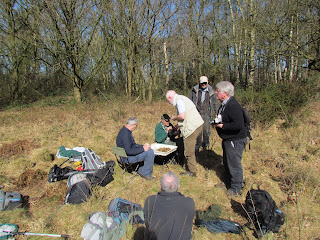As I start this brief report on our trip to Steel Heath I had as some background music a song by John Ireland and the words "this is the weather" stood out. What better title for this trip which turned out to be as much about enjoying a day out and about in unexpectedly glorious warm sunshine in cloudless skies as finding fauna and flora of interest.
Seven of us met up at the unmade track that serves as the car park. After assembling our kit, donning suitable footwear and, as it turned out, unsuitable outer clothing we set off into the woodland that now dominates what a couple of the group remembered as open heath.
A damp hollow covered in leaf litter was our first area for investigation and the vacuum sampler affectionately known as Moth Vac was brought into action. Whilst its "catch" was checked a Brimstone flew by. It was clearly interested in what we were doing on its patch as it came back. It was netted for its trouble. Needless to say it was not too happy at this treatment and refused to pose for a photograph. So some safe gentle handling was needed.
We were surprised to find a leech.
We moved on. This was not easy as there were no paths. Eventually a track was found and followed. This led past a further damp hollow that may have been a pool in the past and then through some denser woodland where a 10-spot ladybird was observed and photographed.
The path led to a clearing. But access was tricky as it seemed to be guarded by bramble and wild rose. Having picked the least painful way through the thorns we then had to negotiate very uneven ground caused by ant hills and tussocky grass.
The clearing had a few clumps of mature heather and some small gorse bushes. These became the centre of attention for a while. Careful looking found a Gorse shieldbug sunning itself. Nearby a pair of spiders attracted the attention of the camera.
Whilst some of us spent our time in the clearing others investigated the surrounding birch dominated woodland. Unfortunately not a lot was found but our springtail hunter did find Neanura muscorum on a piece of damp wood.
This species does not have the ability to spring but is still pretty nifty and can disappear from view quite quickly.
Time for lunch - a working lunch - over a fresh tray of Moth Vac material.
Throughout our time in the clearing there were a few butterflies enjoying the weather, occasionally meeting and spiralling into the sky. A comma rested long enough to be photographed.
Time to move on, but not before one final beat of the gorse bush! This produced a male common earwig and a few springtails - Entomobrya nivalis.
We decided to end the day at Prees Heath, which was just a mile or so away from Steel Heath. Here we spent most of the time just looking and enjoying the weather. We paid attention to a few willows that were bearing flowers in the hope of spotting some early season hoverflies then wandered over to the pool.
At the pool we were greeted by the wonderful sight of toads passing the time of day sitting on the bottom of the pool. I am told that they were males awaiting the arrival of a female. Every now and again there would be some activity as one swam to the surface or walked across the vegetation covering the pool bed. Moving around the pool we found a couple of mating balls where a female had been ambushed by several males as they competed with each other to mate. Unfortunately this is dangerous for the female as she can be killed by all this attention.
It was tempting to spend the rest of the day sitting by the pool but we dragged ourselves away and made our way back to the cars via the main sandy, heather strewn area of the site. Here the wolf spider Alopecosa barbipes was found wandering about.
What an excellent day. This really was the weather to be out and about enjoying what nature has to offer.
My thanks to Shropshire County Council for permission to visit Steel Heath and to David Williams, Jim Cresswell and Bob Kemp for providing the excellent photographs.





















































